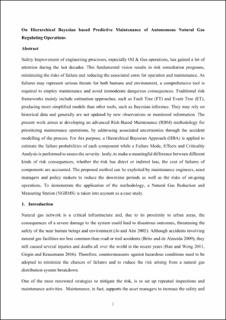| dc.description.abstract | Safety Improvement of engineering processes, especially Oil & Gas operations, has gained a lot of attention during the last decades. This fundamental vision results in risk remediation programs, minimizing the risks of failure, and reducing the associated costs for operation and maintenance. As failures may represent serious threats for both humans and the environment, a comprehensive tool is required to employ maintenance and avoid immoderate dangerous consequences. Traditional risk frameworks mainly include estimation approaches, such as Fault Tree (FT) and Event Tree (ET), producing more simplified models than other tools, such as Bayesian inference. The present work aimed at developing an advanced Risk-Based Maintenance (RBM) methodology for prioritizing maintenance operations, by addressing associated uncertainties through the accident modelling of the process. For this purpose, a Hierarchical Bayesian Approach (HBA) is applied to estimate the failure probabilities of each component while a Failure Mode, Effects and Criticality Analysis is performed to assess the severity. With Markov Chain Monte Carlo simulation from likelihood function and prior distribution, the HBA is capable of incorporating the fluctuations and uncertainties associated with operational data including the variability between the source of data and the correlation of observations. Lastly, to make a meaningful difference between different kinds of risk consequences, whether the risk has a direct or indirect loss, the cost of failures of components is accounted for. To demonstrate the application of the methodology, a Natural Gas Reduction and Measuring Station (NGRMS) is taken into account as a case study. The outcome of the case study proofed that PTG and pump are the most failures sensitive components among other if they being left unattended in the operation with an average number of failure occurrences of 67 and 45; While the THT pipelines and THT tank are less sensitive for being considered for major maintenance request with almost average of 5 times in their lifetime. The proposed method can be exploited by maintenance engineers, asset managers, and policymakers to reduce the downtime periods as well as the risks of on-going operations. | en_US |

